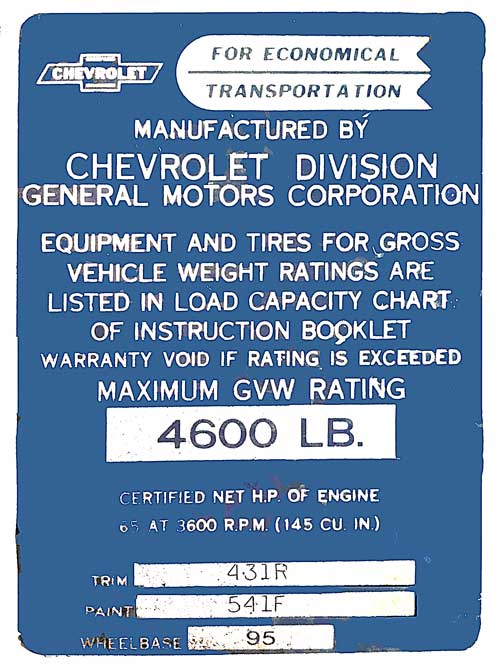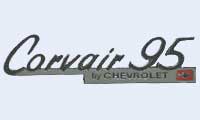Exception Control Letters for
Cowl Plate Paint & Trim Codes
Links to documents and other pages
About ECLs
ECLs were used by Chevrolet to specify a particular configuration of a RPO. They were the basis for ordering parts from suppliers and informing the assembly line of exactly which parts were needed for each vehicle. When assembly of a vehicle commenced, line workers needed to know which parts were required and that all the required parts would be available. The accountants needed to know the costs. Generating complete parts lists for each vehicle model in its standard, or base, configuration was relatively straight forward, but tracking the parts and costs for RPOs was a far more complicated matter. RPOs frequently had different configurations when installed on different models. For example, the Custom Equipment package for R1205/44/54 was quite different than for the Greenbrier. Additionally, when different RPOs were ordered together, their parts lists might need to be modified with additions, deletions or substitutions, such as when Custom Chrome (RPO 393/V37) and Wheel Covers (RPO 132/P01) were combined and the chrome hubcaps were deleted from RPO 393/V37. Interactions between options are not always obvious: RPO 123/U60 (Radio) differed for vehicles with standard and automatic transmissions because different accessory wiring harnesses were needed. The myriad interactions between RPOs created many different installation configurations - in both 1962 and 1963 there were 27 different configurations just for RPO 123 (direct air heater). Tracking the specific parts required for all of the different RPO configurations, and their costs, was a potential bookkeeping nightmare.
The solution was the Exception Control Letter (ECL) system: for every possible RPO configuration the Engineers created a separate parts list and assigned a unique ECL. With the appropriate ECLs appended to the RPOs, the plant could identify all the parts needed for assembly of each vehicle. When construction commenced, the vehicle was built according to the RPO codes on a Broadcast Sheet that accompanied the vehicle down the line. Documents called Exception Control Letter Sheets showed how different RPOs were configured for each ECL, and Engineering Parts Lists identified everything needed for each configuration. Not uncommonly, RPO configurations changed during a production year, necessitating corresponding changes to the ECLs, and further complicating the task of deciphering the ECLs today.
Paint Code RPO Exception Control Letters
The paint color RPOs for Corvair 95s ran in a 7xx series in 1961, but in a 5xx series from 1962 on. Each color had a separate RPO for application as a solid (monotone) exterior or two-tone, such as, Cardinal Red solid (714/514) and two-tone (740/544), and Brigade Blue solid (507/707) and two-tone (537/736). The main body color was known as the primary color, while the stripe applied in two-tone jobs was called the secondary color. There were two white colors used on FCs. “Pure White” comprised RPOs 721/521 (solid) and 545(two-tone). “CameoWhite”, given RPOs 726/526 (solid) and 747/541 (two-tone), was sometimes referred to as “Off White”. For two-tone vehicles where the primary color was either of the two whites, the secondary color was Cardinal Red. For all other two-tone jobs, the secondary color was Cameo White.
Paint code ECLs were single letters in 1961-63. Available documents and with agreement of registry data indicate that all solid color RPOs carried an ECL of "A", whereas the ECLs for two-tone RPOs were "E" for the Corvan, "F" for Greenbrier, and "G" for pickups. The different codes reflected that two-tone painting was more expensive than applying a solid color, and the process of two-toning a pickup was different and more expensive than for a van. The 1963 Price Information supplement also lists the ECLs "M", "N" and "V - X" for Rampsides, and "H - L" and "P -V" for R1205/06. It seems probable that these additional codes were intended for vehicles with RPOs 521 and 545 (as described below) although no examples have yet been found on cowl plates.
In 1964, Chevrolet endeavored to unify the paint ECLs using two letter codes. For most two-tone paint RPOs, "AA" was appended for R1205, "AB" for R1206 models, and "AC" for Rampsides and Loadsides. The exceptions were RPO 545 (see below) and some R1206 two-tone RPOs that carried the “AA” ECL.
| Paint Exception Control Letters, except RPOs 521 & 5451 |
| Year |
Paint RPO |
ECL |
| All Models with solid color RPOs |
| 1961-'62 |
All solid color RPOs |
A |
| 1963 |
All solid color RPOs except RPO 5211 |
A |
| 1964-'65 |
All solid color RPOs except RPO 5211 |
AA |
| Model R1205 - Corvans with two-tone RPOs |
| 1961-'62 |
All two-tone RPOs |
E |
| 1963 |
All two-tone RPOs except RPO 5451 |
E |
| 1964-'65 |
All two-tone RPOs except RPO 5451 |
AA |
| Model R1206 - Greenbriers with two-tone RPOs |
| 1961-'62 |
All two-tone RPOs |
F |
| 1963 |
All two-tone RPOs except RPO 5451 |
F |
| 1964 |
RPO 5542 |
AA |
| 1965 |
RPOs 542, 549, 5553 |
AA |
| 1964-'65 |
All other two-tone RPOs except RPO 5451 |
AB |
| Model R1244/54 - Loadsides & Rampsides with two-tone RPOs |
| 1961-'62 |
All two-tone RPOs |
G |
| 1963 |
All two-tone RPOs except RPO 5451 |
G |
| 1964-'65 |
All two-tone RPOs except RPO 5451 |
AC |
1RPOs 521 and 545 are described below.
2in 1964 RPO 554 (coppertone) was available only for R1206 and was assigned the "AA" ECL.
3in 1965 only R1206 was produced and new RPOs 542, 549 and 555 were assigned an "AA" ECL, other two-tone RPOs retained the "AB" ECL. |
The ECL system for Pure White FCs was different and more complicated than for the other colors. Most likely, RPO 521/545 were handled differently because Pure White needed to be substituted for Cameo White on other painted features, such as mirrors, bumpers and the hubcaps (see more below).
The 1963 Price Information supplement gives the RPO 545 ECLs as "E, F, H - L" & "P - U" for R1206/05, and "G, M, N, V - X" for R1254. However, only the ECLs "E, F & G" (as in 1961-62) have been observed among vehicles in the registry. The corresponding page in the 1963 Price Information supplement is dated 3/18/63, and the additional ECLs may have been introduced late in the production year. Registry data reveal that RPO 521 also had special ECLs, which seem to apply to all models. So far, only the ECLs "A", "B" and "F" have been found among 1963 FCs, and "C - E" are speculated to have been used.
1963 Paint Exception Control letters
for RPO 521 & RPO 545 (Pure White) |
RPO 521 ECLs
|
RPO 545 ECLs
|
Configurations |
| R10 (All) |
R1205 & R1206 |
R1254 |
| A |
E (R1205) |
F (R1206) |
G (R1254) |
|
| B |
(H) |
(P) |
(M) |
? |
| (C) |
(I) |
(Q) |
(N) |
? |
| (D) |
(J) |
(R) |
(V) |
? |
| (E) |
(K) |
(S) |
(W) |
? |
| F |
(L) |
(T) |
(X) |
? |
| |
|
(U)? |
|
? |
| "()" = ECLs not yet observed among registry vehicles.
|
The Price Information supplement for 1964 shows the RPO 545 ECLs "AA - AF" and "BB - BF" for R1205/06 and "CA - CF" for Rampsides, and some of these ECLs have been observed among registry vehicles. Again, Registry data for 1964 - 65 FCs show distinctive ECLs for RPO 521, which, as in 1963, appear to apply to all R10 models. The RPO 521 ECLs "AB", "BA", "BB", "CA" and "DA") have been observed among vehicles in the registry, and the RPO 521 ECL "CB" is speculated to occur.
1964 - 65 Paint Exception Control letters
for RPO 521 and 545 (Pure White) |
| RPO 521 ECLs |
RPO 545 ECLs |
Configurations |
| R10 (All) |
R1205 & R1206 |
R1254 |
| AB |
(AA) |
BA |
CA |
|
| BA |
(AB) |
(BB) |
(CB) |
? |
| BB |
AC |
BC |
CC |
? |
| CA |
(AD) |
(BD) |
CD |
? |
| (CB) |
(AE) |
(BE) |
(CE) |
? |
| DA |
(AF) |
BF |
CF |
? |
| "()" = ECLs not yet observed among registry vehicles. |
It is not currently known which configurations are associated with the RPO 521 and 545 ECLs, but quite likely they involved substituting Pure White for Cameo White on other painted exterior features, such as bumpers and the hubcaps. The Custom Chrome (V37) and Custom Equipment (Z60) options substituted chrome bumpers and hubcaps, and RPO V37 specified wheel covers instead of hubcaps. Since in some vehicles chrome bumpers and wheel covers replaced the standard painted ones, different painting requirements were required.
Trim Code Exception Control Letters
The 'trim code' identified the configuration of interior features of the vehicle. The base or standard, configuration was identified with a trim code of 'STD', and within each model, the standard configuration was a gray (1961) or fawn (1962-65) interior paint scheme. When the vehicle was ordered as a 'Deluxe' the trim code included the Custom Equipment RPO 431 (1961-62) or Z60 (1963-65). For vehicles assembled in St Louis, Z60 was preceded by the number '5', referring to the factory book detailing the different RPO configurations. The Custom Features RPO was typically followed by one or two Exception Control Letters (ECLs), which identified the specific configuration of Z60 in the vehicle. This table presents the current interpretation of how the Custom Features configurations were encoded in the ECLs.
For example, a 1962 rampside with a trim code of '431N' would have had red themed interior trim. A 1965 Greenbrier with a trim code of '5Z60KB' would have had turquoise interior panels configured for a 6-door model and rear arm rests.
| Custom Equipment Exception Control Letters |
| R1205, R1244, R1254 |
| 431 |
Z60 |
$23.00, except B, P, BA/HA, BC/HC - $21.00 |
| 61 |
62 |
63 |
64 |
65 |
| |
|
Interior Configuration |
| R1254/44 |
Full Front Seat 1 |
| A |
A |
AA/GA2 |
-- |
gray (1961) fawn (1962-64) |
| -- |
N |
AB/GB |
-- |
red interior |
| -- |
(C)3 |
(BB/HB) |
-- |
fawn interior |
| -- |
(H)3 |
(BD/HD) |
-- |
red interior |
| R1205 |
|
| B |
B |
(BA/HA) |
-- |
driver seat only / gray (1961) fawn (1962-65)4 |
| -- |
C3 |
(BB)/HB |
-- |
full bench or two seats / fawn interior |
| -- |
(P) |
(BC/HC) |
-- |
driver seat only / red interior4 |
| -- |
H3 |
(BD/HD) |
-- |
full bench or two seats / red interior |
|
() = no examples yet observed among registry vehicles.
1The full front seat was standard equipment for R1254/44 but optional (RPO 482/A54) for R1205. All Deluxe pickups and Corvans in 1961 received an interior color of gray with silver highlight. In later years two interior colors were available. The interior colors were incorporated into the accent vinyl of the front seat and the vinyl of the left armrest. (Interior door and sidewall vinyl panels were only part of the package for Greenbriers.)
2Because of a midyear change, two sets of ECLs were used in 1964; the first set was published in August 1963 and used for early assemblies; beginning in January 1964 a new set of ECLs was used until R1206 production ended with the 1965 models.
3How these configurations differ from others with a full bench seat (or two halh bench seats) is currently unclear.
4The driver-side only seat was standard equiment for R1205. The auxillary front seat (RPO 264/A57) for R1205 was introduced in 1962. These seats are properly refered to a "half-bench seats", not "bucket seats". It is believed that the driver-side only seat confuguration was priced ~$2 less because the right-side visor was absent. |
| R1206 |
| 431 |
Z60 |
$200.00 |
| 61 |
62 |
63 |
64 |
65 |
| |
|
|
|
|
Interior Configuration |
| Gray (1961) Fawn (1962 -65) |
| (D)1 |
D |
(CA)/JA2 |
(JA) |
6-door with a single rear seat |
| (E) |
E |
CB/JB |
JB |
6-door with 3rd rear seat3 |
| (F) |
F |
(CC)/JC |
JC |
8-door with single rear seat4 |
| G |
(G) |
(CD)/JD |
(JD) |
8-door with 3rd rear seat |
| |
|
|
|
|
Blue (1961) Turquoise (1962 -65) |
| (M) |
J |
(DA/KA) |
KA |
6-door with a single rear seat |
| N |
K |
DB/KB |
KB |
6-door with 3rd rear seat |
| (O) |
(L) |
(DC/KC) |
(KC) |
8-door with single rear seat |
| (P) |
(M) |
(DD)/KD |
KD |
8-door with 3rd rear seat |
|
Red (1961 - 65) |
| H |
Q |
(EA)/LA |
LA |
6-door with a single rear seat |
| J |
R |
EB/LB |
LB |
6-door with 3rd rear seat |
| K |
(S) |
(EC/LC) |
(LC) |
8-door with single rear seat |
| (L) |
T |
(ED/LD) |
LD |
8-door with 3rd rear seat |
|
Green (1961 - 65) |
| R |
W |
(FA)/MA |
(MA) |
6-door with a single rear seat |
| S |
X |
(FB/MB) |
MB |
6-door with 3rd rear seat |
| (T) |
(Y) |
(FC/MC) |
MC |
8-door with single rear seat |
| U |
(Z) |
(FD/MD) |
(MD) |
8-door with 3rd rear seat |
|
() = no examples yet observed among registry vehicles.
11961 Chevrolet Car and Equipment Prices book shows 'D-U' as the R1206 RPO 431 ECLs. Although there are few data sets for deluxe '61 Greenbriers, the configuration assignments shown above seem reliable.
2Two sets of ECLs were used for 1964 models. The first set (C, D, E & F series) was published in August 1963 and used for early assemblies; beginning in January 1964 a new set of ECLs (J, K, L & M series) was used until R1206 production ended with the 1965 models.
3When ordered with RPO 269/A59 (3rd rear seat), RPO 431/Z60 included rear compartment arm rests. The available data suggests the a 'B' & 'D' ECLs included the armrests, but it's possibly that it was 'A' and 'C'.
4When ordered with left side doors (RPO 645/E85), RPO 431/Z60 for an 8-door Greenbrier substituted separate vinyl panels for each of the doors for the single large panel used in a 6-door van. |
Example Cowl Plates
(some of the images have been 'photoshopped' for clarity)
| '431' is the 1961-62 RPO for Custom Equipment. The'A' trim ECL is for a gray interior, as expected for the RPO '727' paint code for a two-tone turquoise exterior. |
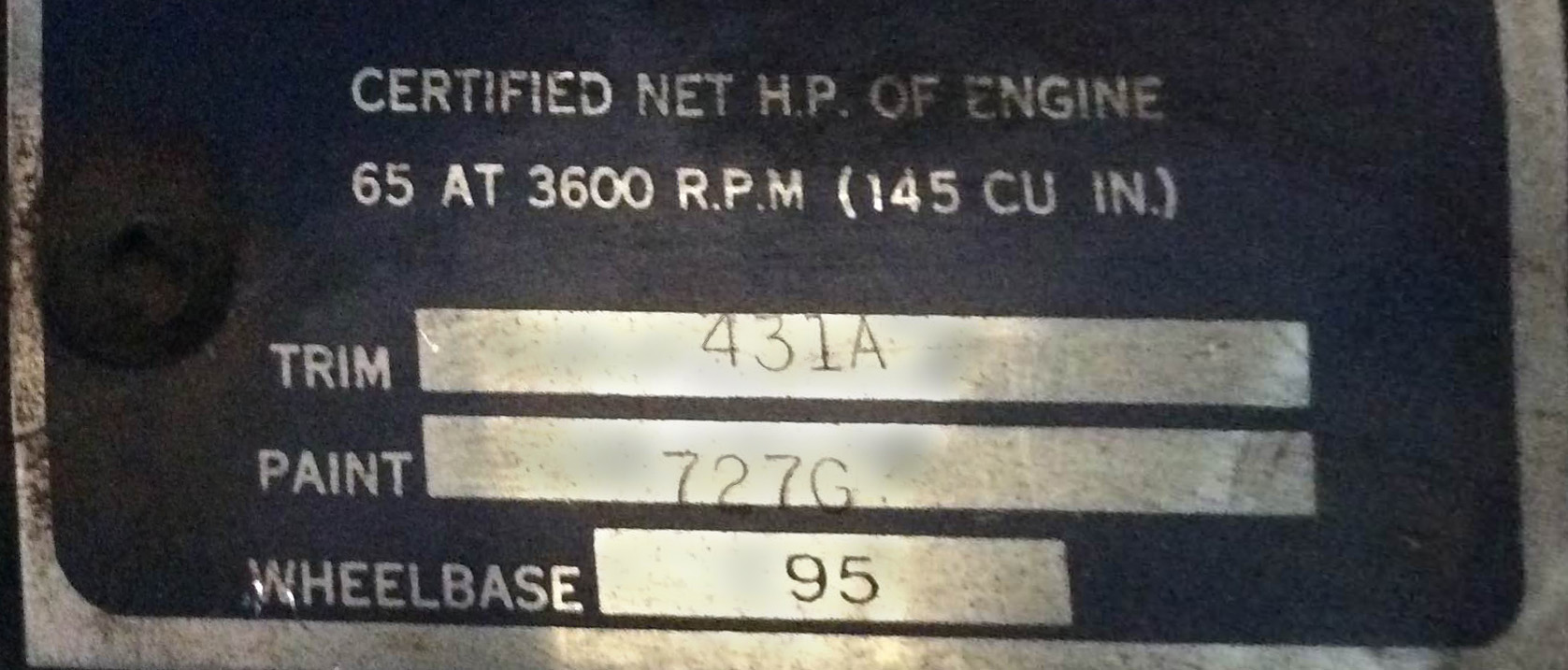
Source: 1961 Rampside
Trim Code: 431A, Paint code: 727G |
| This Rampside was assembled in Flint. The Flint plant did not include the full paint and trim code on the dataplate for the 1963 and '64 mdels. The leading '5' book number was not included and in 1963 the paint code lacks an ECL. (See discussion of '64 plates below.) |
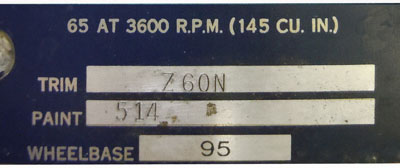
Source: 1963 Rampside
Trim Code: Z60N, Paint code: 514 |
| RPO '521' is the paint RPO for solid pure-white exterior, and the 'A' ECL also specifies solid color exterior. 'Z60' of the trim code is the RPO for Custom Equipment, and the appended 'N' ECL indicates a red interior. Single letter ECLs were used from 1961-63. |
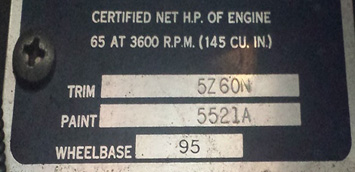
Source: 1963 Rampside
Trim: 5Z60N, Paint: 5521A |
| 'SPEC' (Special) was the paint code often found on fleet vehicles. The 'STD' trim code indicated standard (not Deluxe) interior trim, which was gray in 1961 and fawn in later years. |
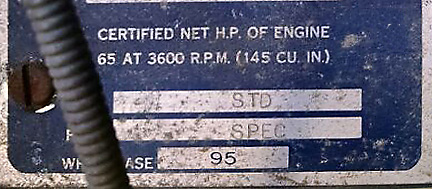
Source: 1963 Corvan
Trim Code: STD, Paint code: SPEC |
| 'Z60' is the 1963-64 RPO for Custom Equuipment. The trim ECLs are 'DB' which includes the early production code 'D' is for turquoise interior, as expected for the RPO '540' paint code for a two-tone turquoise exterior. The 'B' indicates Z60 is configured with the single left-side intermediate vinyl panel for a 6-door and the rear seat armrests included when RPO 269/A59 (3rd rear seat) is also ordered. |
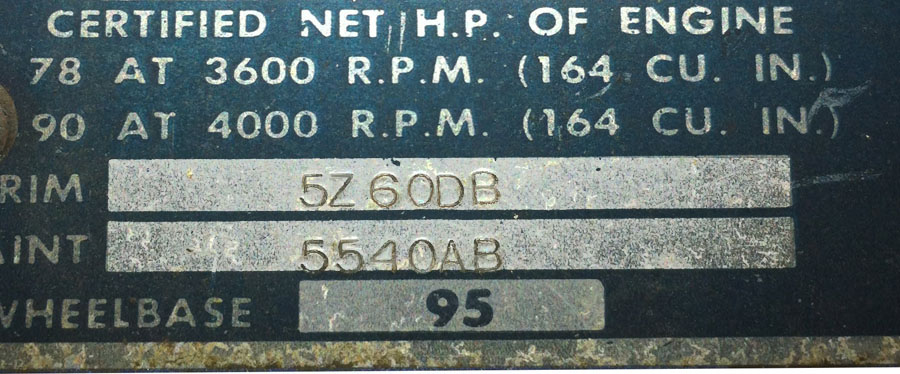
Source: 1964 6-door Greenbrier
Trim: 5Z60DB, Paint: 5540AB |
| In 1963 and '64 the Flint assembly line did not stamp the full paint and trim codes on the data plate. It never included the leading '5' book number and as shown above, in 1963 the paint ECLs were not included after the paint RPO. For the few months that Flint produced Corvair 95s for the '64 model year (production ended Jan '64), it also failed to add the trim code ECL after the 'Z60' RPO. |
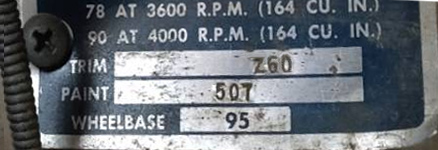
Source: 1964 6-door Greenbrier
Trim: Z60, Paint: 507 |
Notice that the 1964 (and 1965) plate identifies the standard 164 cu in engine whereas the 1963 (and earlier) plate shows the 145 cu in engine.
| Thanks and Acknowledgements |
|
I would like to thank Paul of winvoices.com for sharing his extensive knowledge of the Chevrolet ECL system and continual help in tracking down Corvair 95 Trim and Paint Codes. Winvoices.com provides reproduction window stickers, dealer invoices, car shippers, etc. Much gratitude goes also to Kent Sullivan, who has maintained a registry of cowl plate and other information on his CorvairKid website and graciously provided digital files of those records, as well as codes for other vehicles, and helped with numerous discussions of Corvair 95 options and accessories. Thanks to John Hinckley of the NCRS and Keith Seymore (prior Chevrolet Flint Assembly Line Supervisor) for sharing their knowledge of the Chevrolet RPO and ECL systems; Paul C also gave continual help in tracking down Corvair 95 trim and paint codes. Dave Newell, expert in all things Corvair, provided a key document and several essential insights. Thanks to Mark Corbin, Dave Newell, Dennis Dorogi and Paul C for providing window stickers and truck shippers; and to Ray Sedman, James Dunham, Chris Pickel, Molly Bacon, Chris Brown and Gary Moore for collecting FC codes at several Corvair shows. Also, much gratitude goes to all of the FC owners who sent information about their vehicles, often times responding to my requests for more information. The data you all provided contributed significantly to the "critical mass" of data needed to decipher the codes to the extent now possible.
|

